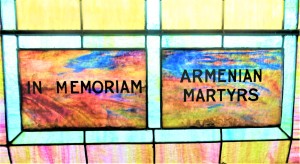I grew up in a community of Armenians. Every block within a 4-5 block diameter contained multiple Armenian families, and at the center of it was the church.
The groundbreaking for the first church was celebrated by the entire congregation. At the time, it was the Armenian Presbyterian Church, although most of the Protestant Armenians attended. It was completed in 1908. The church was the hub of our Armenian community’s life and the commonality we all shared.
But each family was distinct from the others. What village in the old country was their origin? How many stops did they make on their way to America? What skills did they bring with them when they fled their homeland? What struggles with the Ottoman Turks had they endured before they left their homes behind? Did they worship as Presbyterians or Congregationalists?
Some left their homeland in the mid- to late 1890’s, when the Turkish leaders initiated random massacres of individuals, of families, of entire villages–long before the more widely known Genocide that began in 1915. Some saw the clouds forming during the first decade of the 20th century, as the Ottoman Empire was crumbling and weakening, and the Young Turks were gaining power.
1.5 million Armenians did not leave in time, and were murdered with a range of “weapons” beginning in 1915. Justified as a response to World War I, the Turks killed younger men with guns, hangings, burnings, hard labor combined with starvation, and other gruesome methods. Women, children and old men were subjected to humiliation of nakedness, starvation, freezing, and the infamous walks across deserts and mountains to nowhere–including women and children being dragged to the nearest rivers to be washed away–all called “relocation.”
My little church in Troy, NY was a haven and support for those who came early. From the beginning there were internal battles–over leadership, over denomination (primarily Presbyterian vs Congregational), over personalities–that led to a breakup of the church community in 1910. The Congregationalists worshipped in borrowed space and began planning a new house of worship in 1912. The groundbreaking for that church in 1914, although the actual building of the church didn’t begin until 1916. By that time reports of slaughter and terrible massacres and deportations were arriving, leading the Congregationalists to rename the church as the “Armenian Calvary Congregational Church of Troy.” The church name commemorated a martyred nation following her master to Calvary. Newcomers, it was believed, would “revigorated the blood in the veins of the new built church” and “America would be the adopted country of Armenians.” The church would support the wave of Armenian immigrants escaping the genocide in their Americanization.
On August 27, 1916, the cornerstone was laid with fitting ceremonies. And on January 7, 1917, the first service was held in the building.
In 1914 the two Protestant Armenian churches began talks to unite, and the first union services was held in 1919. The new church became the home of the congregation and the Presbyterian church became the parsonage. The church was renamed United Armenian Calvary Congregational Church.
One of my personally favorite parts of the church are the stained glass windows that memorialize the Armenian martyrs. The mass loss of family members was immortalized, and the importance for the Armenian church community to be a source of support for arriving survivors strengthened the entire community.

It was this history and my personal experiences growing up within the church community that connected me forever.




